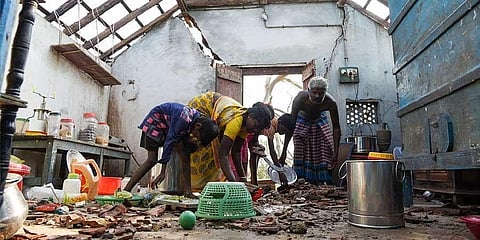

NAGAPATTINAM: Battered and bruised by disasters, both man-made and natural, on several occasions, Nagapattinam district has come a long way in the 30 years since its formation, with much resilience and spirit. TNIE takes a look at the struggles and how it fought against all odds.
The first major disaster came in the form of huge tidal waves hitting the shores up to a height of 16 feet on December 26, 2004. Tsunami claimed lives of at least 6,000 people and damaged houses, boats, shops, properties, etc.
Recalling the times, J Radhakrishnan, the then Collector during tsunami relief, who is now the Principal Secretary of Health and Family Welfare, says, "We worked a lot to provide relief for the losses and re-establish livelihoods. We had the backing of the State government and lots of non-profit organisations in rebuilding the coastal areas of Nagapattinam district. I carry the confidence I got from tsunami relief till date."
Over a hundred children who had lost their parents to the tsunami were admitted to Annai Sathiya Government Orphanage Home established that year. All of them had left after completing higher secondary school education.
M Girija, a 57-year-old teacher and superintendent in-charge, says, "The children have all grown up. Some are settled in marriages. Some are pursuing higher studies. Some come back to visit us on December 26 every year to commemorate the anniversary of their lost families."
Victims who lost their houses were given 'tsunami row houses' in urban areas. However, many houses have become dilapidated and requires renovation.
Even before the district could recover from the losses, it was faced with cyclones one after the other -- Nisha in 2008, Thane in 2011 and Gaja in 2018. Major livelihoods such as agriculture, fishing, horticulture, floriculture, and salt production were affected.
The worst damage was in Vedaranyam block. Workers in the Power Department had to work three shifts a day to restore power to households. Over 70 per cent of paddy cultivation in integrated Nagapattinam district was affected in the Burevi cyclone in 2020.
Dr S Suresh Kumar, the then Collector during the Gaja cyclone's impact, who now works as the Director of Minority Welfare, said, "We reduced the human losses to a minimum by our actions. We worked tirelessly to provide drinking water, power supply, disease control, accessibility, and food supply and bring back normalcy in the months that followed. The people who were upset slowly realised and cooperated with us during our relief works. Their resilience and spirit are commendable."
Although disasters cannot be prevented, experts advise better preparedness measures in place. Dr K Palanivelu, Director of Centre for Climate Change and Adaptation Research, Anna University, said, "It is important to build a sufficient number of storm shelters according to the coastal population. The urban areas should have more stormwater drains and rural areas with drain channels. The power supply should be more underground in place of overhead power lines."
On the other hand, drought hit the district in 2016. Several dozens of farmers died either of suicide or by heart attack after their cultivation failed due to lack of irrigation and rainfall, which the district continue to face till date.
(This is part three of the three-part series)
PART ONE - Nagapattinam@30: Port’s lost glory